HyperCard, the lost link in the evolution of the Web
Before the Web could do anything, HyperCard did everything.
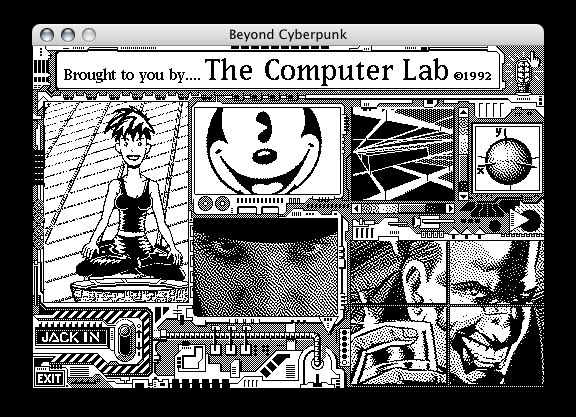
Somewhere around 1988, the owner of my apartment made a deal with me. She will buy a Macintosh computer, I will buy an external hard drive, and we will leave this system in the living room to use it in turn. For the most part, she used the computer because I did the computation on the IBM 286 and just wanted to track Apple's progress. However, after we set up a Mac, one evening I noticed one program in it in the application menu. “HyperCard?” I thought. "What is it?"
I opened the program and read the instructions. HyperCard allowed you to create “piles” of cards, or visual pages on a Mac screen. It was possible to insert “fields” in them, where the text, tables or even images were shown. It was possible to put "buttons" that linked the cards from the pile to each other, lost different sounds by pressing - I especially remember one rattling sound that I can not forget to this day. It was also possible to turn images into buttons.
In addition, the HyperCard program had a HyperTalk scripting language that even a non-programmer could learn (which I was). It allowed developers to embed "go" or "play sound" or "disappear" commands into the components of the HyperCard array.Five cool stacks of HyperCard
1. The most famous project in the history of HyperCard was probably Myst . Cyan released the game in 1993, but it took two years for the founders of Cyan, Rand and Ryan Miller to build complex landscapes that had fascinated an entire generation. The disc contained 40 minutes of music, 2500 images and an hour of video in QuickTime format.
2. Before Myst, the Millers made noise with their game The Manhole (1987), specially designed for children. Before entering the CD, the program required working with a bunch of floppy disks on which 600 interconnected screens were stored. You can watch the game with a YouTube clip.
')
3. The Whole Earth Catalog team found out about HyperCard before the program was launched on the market in 1987. “The scale of the catalog and its natural division into cards made it an ideal way to test the program’s capabilities from an Apple perspective,” Kevin later recalled . so Apple "sponsored us to tell them everything we’ll find out by processing the catalog into the HyperCard format." Whole Earth Hyperlog contained 9742 pages and cost $ 150.
4. An almanac of the Time Table of History was published in the HyperCard format. It was mainly about science and technology, and it was released on a CD for Macintosh in 1991. It contained more than 6,000 hypercards, and it was sold for $ 150.
5. It is also worth remembering the online catalog of books from Voyager Company . In the late 1980s and early 1990s, the company released an amazing series of interactive CDs, including an electronic version of comic Art by Spiegelman Maus, "Companion to Beethoven's 9th Symphony" and the popular Beatles film "A Hard Days Night" in the form of a "book with a film in the kit. The choice of HyperCard was “logical”, as explained in the description for the series. HyperCard, "simulating a stack of cards, is close in spirit to the book."
I became interested in this, and began to make up piles. None of them became anything more than just a set of hastily created images, sounds and aphorisms, but at some point I looked at my watch, and found that it was already 4 in the morning. I was amazed and exhausted, and lay down to sleep, while the visual components of the stacks of cards danced in my head.
And if you look at our historical clock, then HyperCard will turn 32 in August 2019. What happened to this program? I searched and found the panegyric of this program from entrepreneur and programmer Tim Oren, dated 2004, written in the week when Apple removed this program from the market. He argued that the HyperCard problem was that Apple could not figure out what the program was for.
“What was it?” Wrote Oren. “A tool for programming and designing user interfaces? Lightweight database and hypertext document management system? Media creation environment? Apple never answered that question. ”
Therefore, the company from Cupertino sent this program into exile to its division of Claris, where it was lost among more interesting projects, for example, Filemaker and the ClarisWorks office suite . “With Apple’s tacit agreement after it swallowed Claris again, the most dedicated fans, especially from the educational community, supported the life of this program,” continued Oren's epitaph.
But before the cessation of development, the inventor of HyperCard foresaw its end. In a disturbing 2002 interview, Bill Atkinson confessed to his “terrible mistake.” If he had thought that the stacks could be tied together in hyperspace, and not just installed on specific computers, everything would be different.
“I missed HyperCard,” complained Atkinson. - I grew up in a culture bounded by Apple. If I grew up in a network culture such as Sun, HyperCard could be the first web browser. My blind spot at Apple didn't let me turn HyperCard into the first web browser. ”
HyperCard may not have become the first web client, but I think it deserves a bigger place in the history of the Internet.
Computer library

In the year the HyperCard Television Show was released from San Francisco, Computer Chronicles released a program about this program. And the episode presenters quickly determined what it was based on.
“HyperCard is based on hypertext,” said Gary Kildall to Stuart Cheifet. - This concept was invented by Ted Nelson and Doug Engelbart in the 60s. The basic idea is this: if we try to conduct research on any topic, then materials on it exist in all sorts of different places. These can be books, magazines, tapes, Compuserve [the first major commercial Internet provider in the US / approx. trans.] - and it would be great to somehow link all this electronically, so that, let's say, we could, by clicking on Beethoven, jump from one page to another ... This was the essence of hypertext. ”
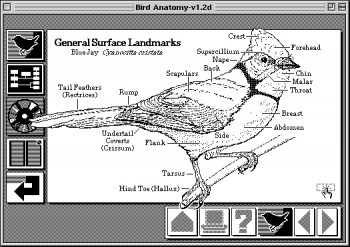
Theodore Nelson proposed the concept of hypertext back in the 60s and tried to implement it in the unfinished project Xanadu . Without losing enthusiasm, Nelson became an expressive preacher of this idea. In the 1974 Computer Lib / Dream Machines book, he defined hypertext as “a form of recording that forks or performs an action upon request; it is best expressed on a computer display. ” By simplifying the process of distribution and access to information, hypertext and hypermedia could free society from those whom Nelson considered an overly professionalized elite of digital information.
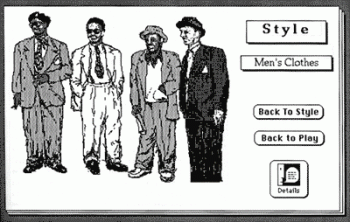
“As the saying goes, war is too important to give it to the care of generals,” Nelson wrote. “The custody of computers can no longer be left to the clergy.”
However, the very "clergy" quite well released the technology at will in the 1970s. Three years before the book was released, the ARPANET architects, a prototype of the Internet from the Department of Defense, revealed their project details at a public event in Washington, DC Meanwhile, two engineers from Bell Laboratories at AT & T worked hard on UNIX, the operating system that would become the backbone of the network. Fearing government antitrust repression, AT & T did not stay on the software market, and gave UNIX to colleges and universities at discounted prices. And these schools, with the financial support of the National Science Foundation, created hundreds and then thousands of ARPANET nodes in the 1980s.
And then came 1989, when a programmer from CERN, a huge Swiss physics lab, suggested using a hypertext network there. “Most of today's systems use a single database,” explained Tim Berners-Lee . - And this provides access to many users using a distributed file system. Few products literally embraced the idea of Ted Nelson about the “docuverse universe” [docuverse], allowing you to put cross-references between nodes in different databases. ”
However, Berners-Lee was determined to create one.
On the way to the web
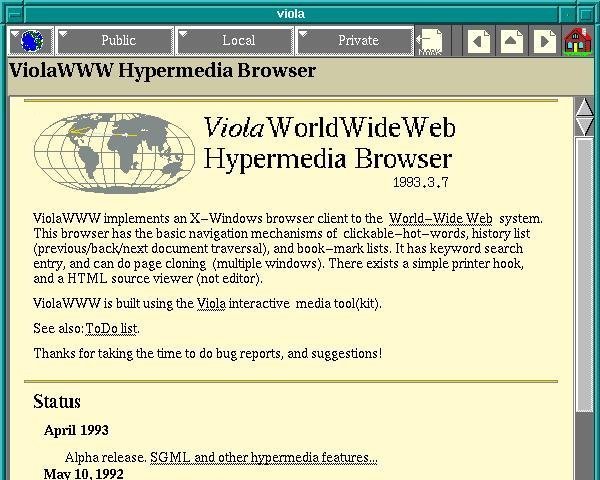
ViolaWWW HyperCard Inspired HyperCard Browser
About two years later, Berners-Lee created his own web browser, and then published the library of this project so that programmers could develop their own versions. Soon a group of Finnish students developed the Erwise browser. Unfortunately, at that time the country was in a protracted recession, which greatly restricted the possibilities of Erwise.
“At that time in Finland it was impossible to build a business on Erwise,” explained one of the team members. But other developers also downloaded the code of Berners-Lee. Among them was Pei-Yuan Wei, who worked on the UNIX X terminal at the Experimental Computing Division of the University of California at Berkeley. Where did Wei get his inspiration for his browser ViolaWWW? He was thinking about a program that he really liked, although he didn't even have his own Mac.
“Then HyperCard looked very attractive, graphically, with these hyperlinks,” Wei later recalled. “I got the instructions for HyperCard, I studied it, and just implemented all the concepts in X-windows”, in the UNIX visual component. In the final browser, Viola had HyperCard components: bookmarks, history, tables, graphics. And he, like HyperCard, could run programs.
That was in 1992. By then, a web client for the Mac was already being developed — it was done by Nikola Pellow and Robert Kailiau Samba, also influenced by HyperCard. And all this activity was enthusiastically watched by young developer Mark Andriessen from the National Center for Supercomputer Programs at the University of Illinois. The Andreessen team launched the Mosaic browser in January 1993; It was the first browser to work right away on PC, Mac, and UNIX. Mosaic turned into Mosaic Netscape a year later.
Soon after, I downloaded Netscape on a PC from Dell. “Wow,” I thought, going over different sites. “This is very similar to HyperCard.”
HyperCard Legacy
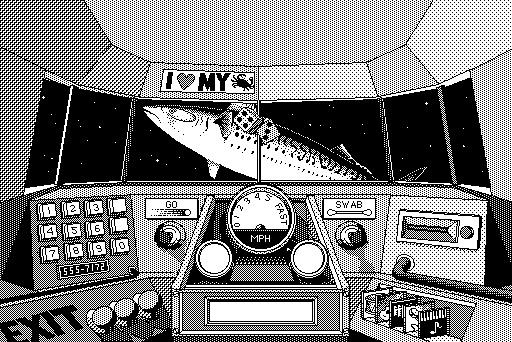
HyperCard Cosmic Osmo game still available on Steam
What is the place of HyperCard in the history of innovation? Of course, there is a temptation to indulgently treat the program by comparing it, say, with an optical telegraph , a virtually forgotten predecessor of the magnetic telegraph ; or with mechanical television by John Lougie Byrd , the forerunner of electronic TV; or with experiments to download music via cable or from William Meister's satellites, the unfortunate but inspiring appearance of America Online.
However, all these projects failed. HyperCard was incredibly popular, and all over the world. The Melbourne Museum Victoria, which describes the scientific and cultural history of Australia, has published a list of the ways in which the Melbourne teachers used this program:
- Bundle of exam questions with choices.
- Collection, storage and use of educational materials, including Excel graphs.
- KeyNote presentations and flyers for students.
- Calculator with a variety of mathematical functions and graphing.
- Interactive science instructions with animation and sound.
- Fractals
- Training material on geographic information system.
- Oil spill modeling.
- Literacy development.
- Road safety.
- Oracle database interface.
- Toxicology database.
- Select and play video tracks.
- Interactive educational presentation of jobs in the wool industry.
- Interactive educational games "Flowers of crystals" and "Grandma's garden".
- "Beach Footprints" - the study of local shores and seashells.
- TTAPS is a program for print learning schools.
Even in August 2002, there were 10,000 HyperCard developers in the world. Three years after the release of the program, the program "Computer Chronicles" has continued, talking about the development of HyperCard. They found software for HyperCard, developed to manage a television studio. MIT released an interactive video magazine based on the program. A seventh grader wrote a timeline for Russian history for HyperCard, and among children even preschoolers played with this app.
Not surprisingly, Cyan programmers initially wrote their incredibly popular adventure puzzle Myst in the form of a HyperCard stack. This explains the excellent graphics of the game and the quality of the animation, interspersed with background sounds or sudden video sequences. But even in 1987, when the Mac was black and white, HyperCard developers and artists produced thin and stunning products that can be rarely found on today's web.
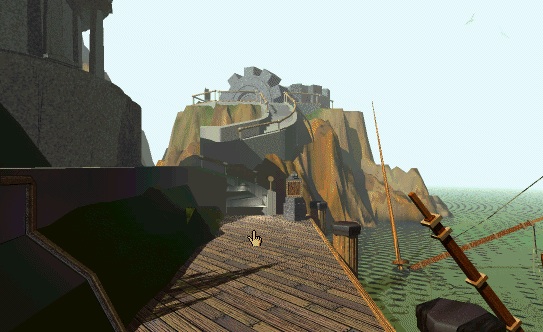
Myst's Adventure Puzzle - Possibly the Top of HyperCard Evolution
How did creator Bill Atkinson define HyperCard? “Simply put, HyperCard is a software building kit that allows people who cannot program to collect interactive information in one place,” he said in 1987 in Computer Chronicles.
When Tim Berners-Lee's innovation finally gained popularity in the mid-1990s, HyperCard had already prepared a generation of developers who knew what Netscape needed for. That is why the most appropriate historical analogy for HyperCard is not some kind of failed and forgotten innovation, but a paraphrase of the famous statement about Elvis Presley. Before the Web could do anything, HyperCard did everything.
Source: https://habr.com/ru/post/457718/
All Articles